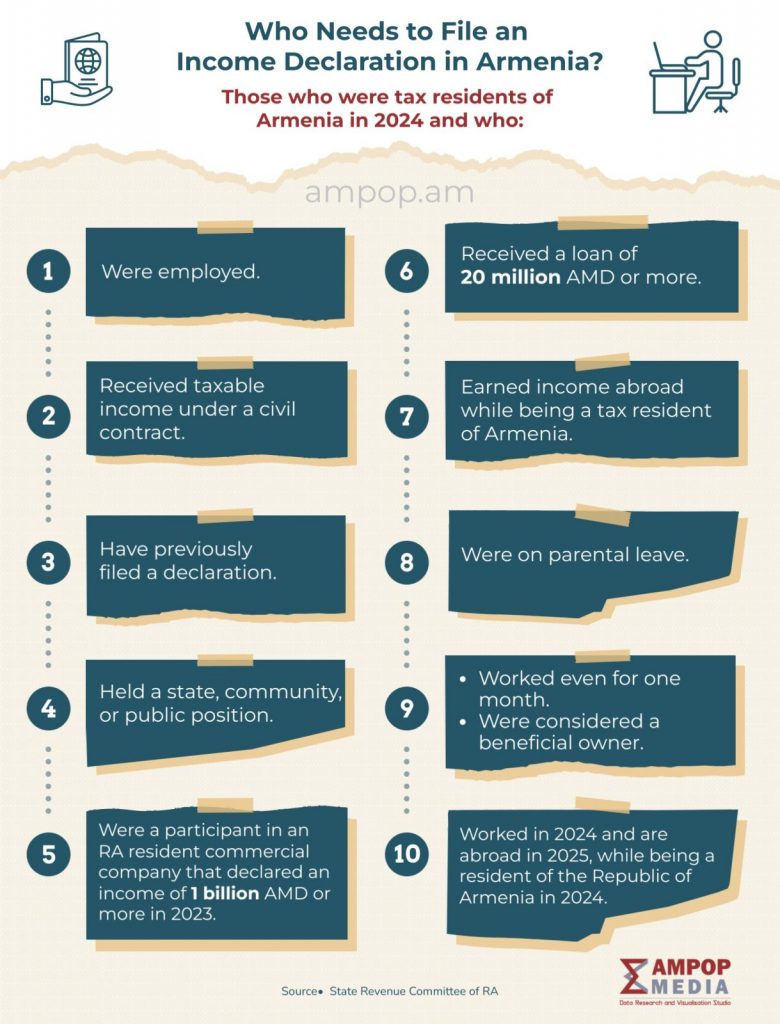In 2022, Armenia adopted a law requiring all employees to submit annual income declarations. Starting in 2023, state employees had to comply; from 2025 onward, the obligation will extend to all workers—nearly 700,000 people. The aim, according to the government, is to create comprehensive statistics on citizens’ income to better target social programs.
Yet the rollout has been bumpy. Many citizens, like 67-year-old teacher and pensioner Alina Antinyan, found the process too complicated to complete on her own. By September 2025, only about 15% of expected declarations had been submitted, despite fines ranging from 5,000 to 50,000 drams for late filing.
Obstacles: ID Cards and Digital Gaps
Income declarations must be signed with an electronic signature tied to an ID card. But most Armenians still lack one. This requirement has overwhelmed police passport offices, especially in Yerevan, leading to long queues and delays. Over 43,000 applications for ID cards were pending in summer 2025, though authorities claim daily card production has doubled compared to last year.
Officials promise that citizens unable to file due to lacking an ID will not be fined, though it remains unclear how this will be verified.
Incentives: Social Spending Refunds
To encourage timely filing, the government offers compensation for certain social expenses. Citizens can receive reimbursements of up to 100,000 drams for education and healthcare costs. According to the State Revenue Committee, by August 8 roughly 43,000 Armenians had already received a total of 3.7 billion drams in refunds through the declaration system.
Purpose and Controversies
The Finance Ministry insists the system is not designed to tax every type of income but rather to gather reliable data for policymaking. For example, money transfers between relatives or friends have no tax consequences but must still be reported.
Transfers from abroad—such as remittances—were taxable even before the reform. The new system simply makes such flows more visible, meaning undeclared taxable income can more easily be identified.
Davit Ananyan, Former Chairman at State Revenue Committee of RA, however, argues that the reform has drifted from its original purpose. Instead of fostering a culture of voluntary compliance, he says, it risks becoming a rushed fiscal measure. He believes it should have been introduced alongside property tax reform and phased in over at least ten years.
Concerns over Privacy and Bureaucracy
Auditors and experts warn that the system increases risks to banking secrecy and personal data. Citizens often turn to private firms for help filling in declarations, handing over sensitive financial information. Critics argue this creates opportunities for misuse, including state pressure on opposition activists.
They also fear the reform will push more transactions into cash and informal channels. Collective payments—such as colleagues pooling money for an excursion—may technically trigger tax liabilities unless documented with contracts. This, critics say, adds “administrative harassment” to daily life.
Another controversial rule exempts transfers under 300,000 drams (around $670) from declaration. Supporters view it as a simplification, while opponents argue it could encourage corruption by splitting bribes into smaller sums.
International Comparisons
Many countries operate income declaration systems, but most apply gradual rollouts, income thresholds, or automated digital platforms. In the U.S. and Germany, only those above certain income levels must file. France requires everyone to declare but relies on a fully digitized system. Estonia is considered a model: the government pre-fills most declarations automatically, leaving citizens to simply confirm the data.
Armenia’s system, by contrast, is still developing. Technical difficulties, poor digital literacy, and incomplete services make compliance harder.
Looking Ahead
Despite criticism, the law is already in effect. By 2026, at least 500,000 additional citizens—including pensioners—will be required to file annual declarations. Parliament promises improvements to simplify the system, but doubts remain about the state’s administrative capacity and public trust.
The reform reflects Armenia’s broader struggle: balancing fiscal transparency and governance modernization against weak institutions, limited digital infrastructure, and citizens’ frustration with bureaucracy. Whether the system succeeds will depend not only on technology and enforcement but also on whether the public sees it as a tool for fairness—or another burden in their daily lives.
This article was originally created in Armenian by Ani Ohanyan
The English summary and the main image were both created using artificial intelligence tools, based on the original article written in Armenian.
The material was produced by Ampop Media in cooperation with the Friedrich Ebert Stiftung (FES). The views and opinions expressed in this publication are those of the author(s) and do not necessarily reflect those of the Friedrich Ebert Stiftung.
Note: All materials published on Ampop.am and visuals carrying the “Ampop Media” branding may not be reproduced on other audiovisual platforms without prior agreement with Ampop Media and/or the Journalists for the Future leadership.
Փորձագետի կարծիք
First Published: 02/10/2025










